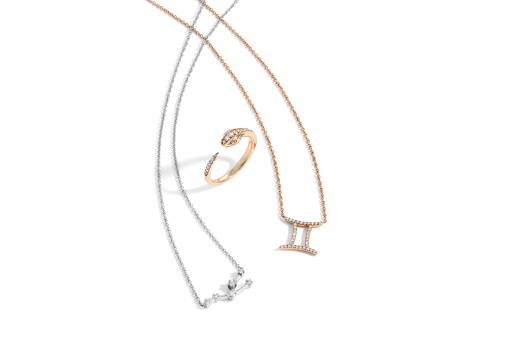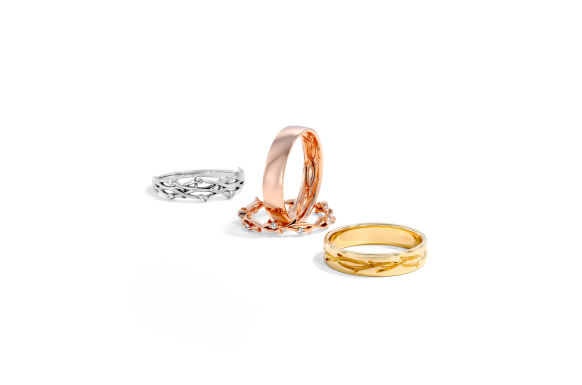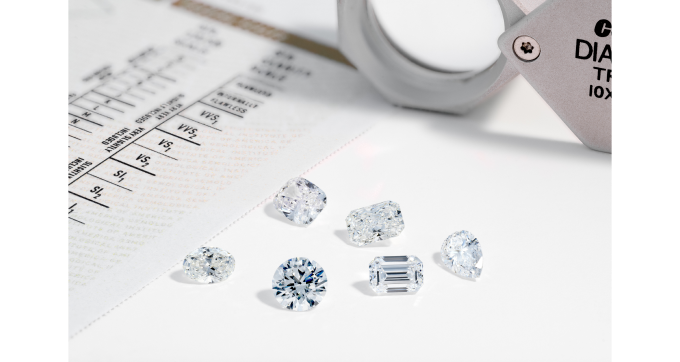Oh, diamonds. They’re absolutely gorge; they’re one of the most desirable precious gems, and they symbolize endless love. And while that’s all great, we know the real reason people have been clamoring after these little rocks for centuries. They’re shiny!
But when it comes down to it, which diamond is the shiniest? There are variations in sparkle from shape to shape, and each cut style has advantages. While we love them all, one does shine above the rest. So who’s the CEO of sparkle-city? Let’s get into it.
A Glimmer Of Glitter
Let’s start from the beginning and look at what makes a diamond sparkle in the first place. All that glitter we think of when we hear sparkle is made up of brilliance and fire. But what is that?
Brilliance is the white light that is reflected back out of the diamond. It causes the little flashes we call sparkle.
Fire refers to colored light. These colored flashes bounce back with the sparkle giving it that twinkle of magic that is diamond sparkle. Generally, more facets mean more sparkle. However, the most sparkly diamond doesn’t have the most facets. Weird, we know.
It’s all because the most light refraction is where you get the best sparkle. So the more light that can enter and bounce back out of a stone, the more sparkle it will have. Cut, facet placement, and symmetry all play a significant role in this.
Supreme Sparkle
Spoiler alert, the round brilliant has the most sparkle. And that is simply because that’s what the cut’s original designer set out to do, and he succeeded big time. This is due in large part to that all-important symmetry.
The round brilliant also has the most optimal facet placement. Its long kite-like facets are equal in shape and distance around the stone. So when the light comes in on one side, it can go straight out on the opposite side.
Fun fact, this cut also hides the most imperfections, meaning you can slide a little lower on the color and clarity scale and still have a beautiful diamond. Many fancy shaped diamonds have brilliant style facets, but nothing can duplicate the sparkle and shine of a round brilliant. That explains why it’s still the most popular shape for engagement rings after all this time.
Secondary Shine
Next on the list of extraordinary sparkles is the Princess cut. No surprise here since its technical name is the square modified brilliant.
Cushions and radiants also make it into bracket number two. All three of these tiny shinies are cut with brilliant style facets, and all three have intense sparkle and brilliance. Princesses and cushions are a great option if you’d like a more square diamond with oodles of shine. And if you're really feeling the rectangle, radiants and elongated cushions won’t let you down in the shine plus finger coverage category.
Third Is The Word
The next level down, or the third most sparkly, depending on how you want to look at it, is the pear, oval, and marquise. Just to be clear, they are all still gorgeous and sparkly. They simply aren’t the most sparkly.
All three have facets that reflect the most possible light and similar facet patterns. Each has amazing brilliance, especially with a good cut. They all provide excellent finger coverage and look larger carat for carat than a round. (Good trade if you ask us.) The Marquise has very similar face facets as a round brilliant. It also provides great symmetry and brilliance.
This sparkle tier also includes the heart-shaped diamond, which has similar facets to a round brilliant. A well-cut heart can have a beautiful shine, but beware, a poorly cut heart is a bit of a bummer.
Different Strokes
Ok, this next step shouldn’t be on the same list. Step-cut stones like Emeralds and Asscher’s have a completely different look than a brilliant cuts. And they certainly don’t share the same sort of sparkle.
These stones feature long symmetrical facets which provide bright flashes instead of the glittery sparkle of a brilliant cut. They also tend to have a more transparent, window-like vibe. When you look down through the table, you’ll see a beautiful hall of mirrors effect. It’s not sparkle, but it is stunning.
Choosing an Emerald or an Asscher is more about style than sparkle. They have a totally different vibe. Call it classic, elegant, old-world beauty. Whatever it is, it’s pure glamor. And if you’re into it, it’s definitely worth trading sparkle for flash.
Bold As Ice
Yet another fun sparkle factor is that crazy crushed ice diamond. Yes, it’s called crushed ice, and it’s a totally different sort of sparkle. Cushions and radiants can both have a crushed ice cut, and it’s a whole new diamond.
In order to make a crushed ice diamond, cutters make lots of tiny facets instead of the larger ones we see in brilliant cuts. This can eliminate diamond waste, a huge plus and selling factor for many earth-conscious couples. The look has more of a shattered glass sparkle. Think of a cup of ice shining in the sun. So, crushed ice gives off oodles of tiny sparkles. While brilliant gives off fewer sparkles, but they’re larger.
A traditional brilliant cut still has tons of sparkle. Looking down at the face of the diamond, you see it has a more obviously faceted look. That detail is what gives brilliant diamonds their dimension.
Crushed ice, on the other hand, has a more white face-up look, which some people favor. Unlike a brilliant cut that can hide some color, crushed ice will show it off. So you’ll probably want to go with a higher color grade if you’re feeling icy. No argument here. Crushed ice has a lot of sparkles. But it’s an entirely different type of sparkle than a brilliant. Which is better? That’s up to you, booboo.
And Another Thing
While we are winding down the sparkle party, there are still a few shine factors to keep in mind if you want to maximize that glittery goodness. A whole lot goes into a diamond, meaning all sorts of diamonds can come out in the process.
The Cut is probably the most crucial factor in diamond sparkle and just diamond buying in general. A well-cut diamond will shine much brighter than a poorly cut one. This is because it bounces back the maximum amount of light.
A poorly cut stone will let all that light slip through, creating dark spots or, in some cases, a dead diamond. That's a total bummer we’d like to help you avoid. If you want to know more about cut, you can check out our 4Cs article all about it. So here’s the thing, only round diamonds have a cut grade. So we high-key recommend checking out any fancy shapes with the HD 360 preview. It’ll give you an up close and personal look at all that sparkle and shine.
Settings can also play a massive role in sparkle. For example, a prong setting is going to let in more light and let out more sparkle.
High-set stones think hidden halo, will let in the most light, which means maximum sparkle. If you want to add a little bonus shine, you can always opt for a setting with a pavé band, a halo–or both. All that sparkle enhances your center stone's sparkle and makes it appear larger. We love to hear that.
Going, Going, Glitter!
The award for doing the absolute most goes to the round brilliant. Not too big a shocker when you consider the cut was designed to out-sparkle the competition.
But don’t gloss over the fancy shapes just yet. They’re giving major sparkle, more affordable on average, and many look larger carat for carat. Whether you’re shooting for brilliant sparkle or tiny shiny crushed ice, you can’t go wrong. And hey, if you’re after an entirely different vibe, step-cut stones like Asscher’s and Emeralds are seriously stunning. Not to mention timeless.
There you have it, your supreme sparkle champion. But when it comes to finding the engagement rock of your dreams, there’s more to it than the shine factor. It’s all about your personal style, so follow your heart.






